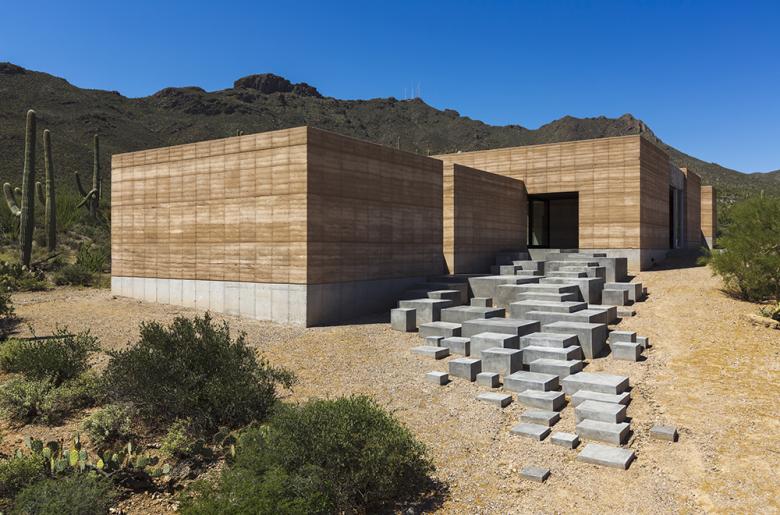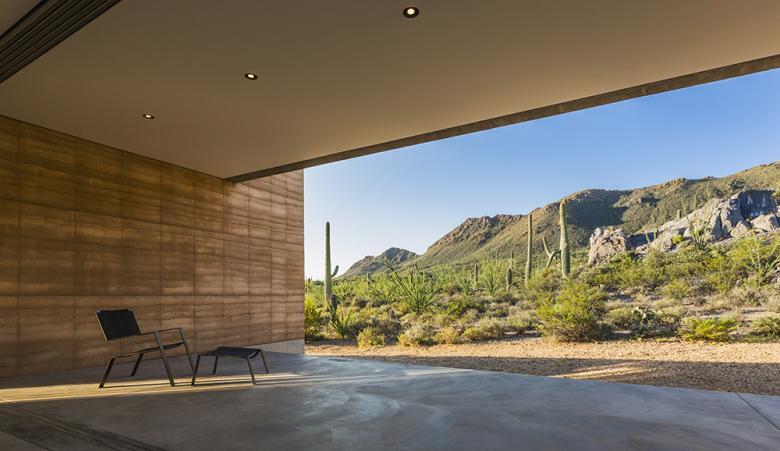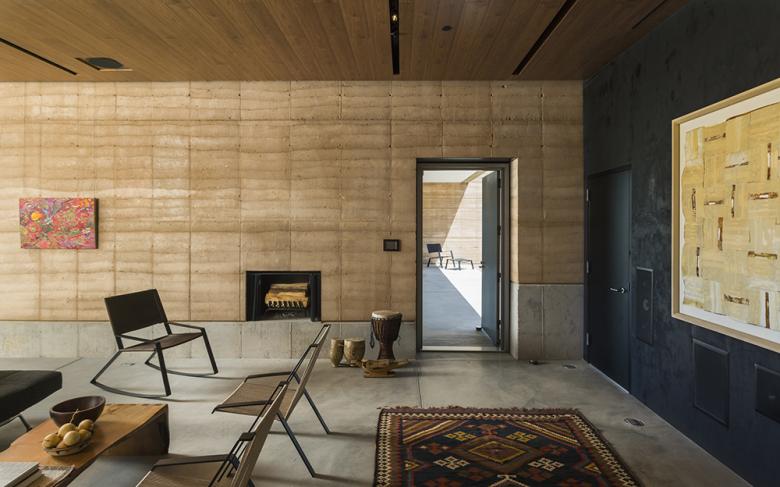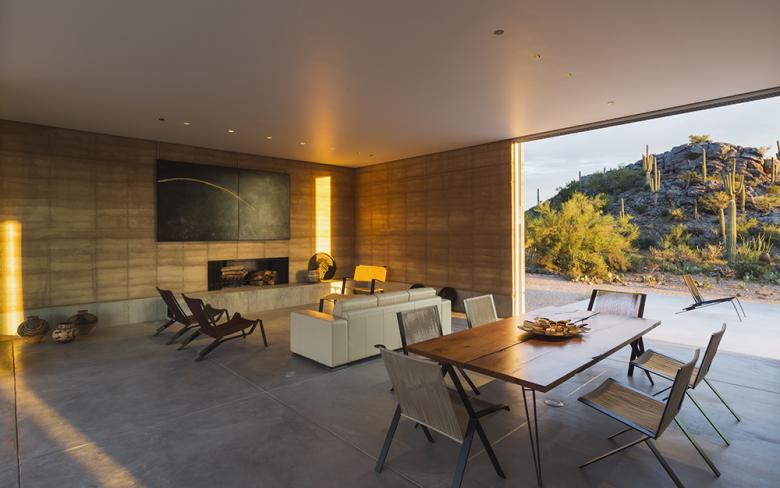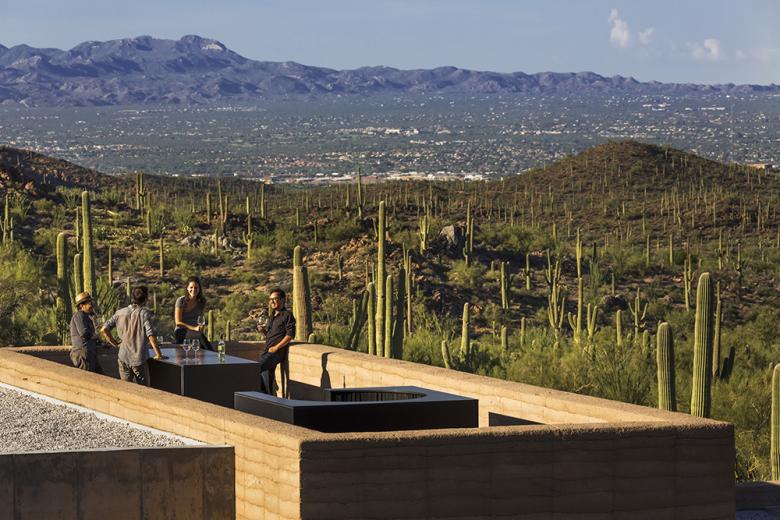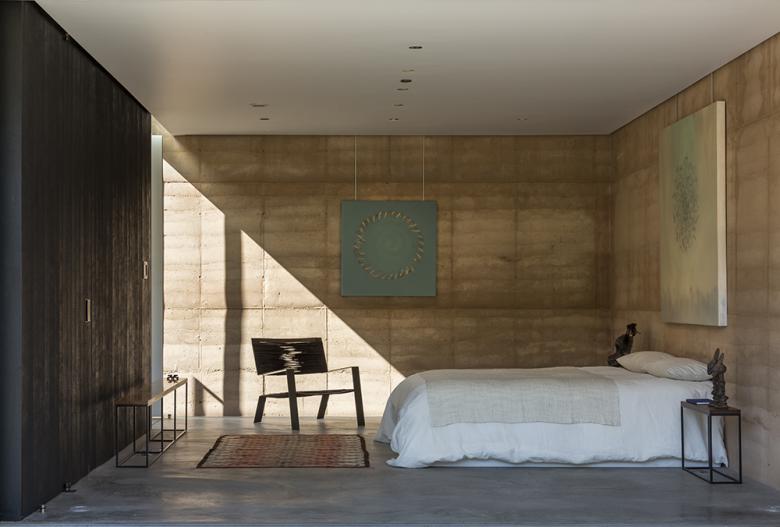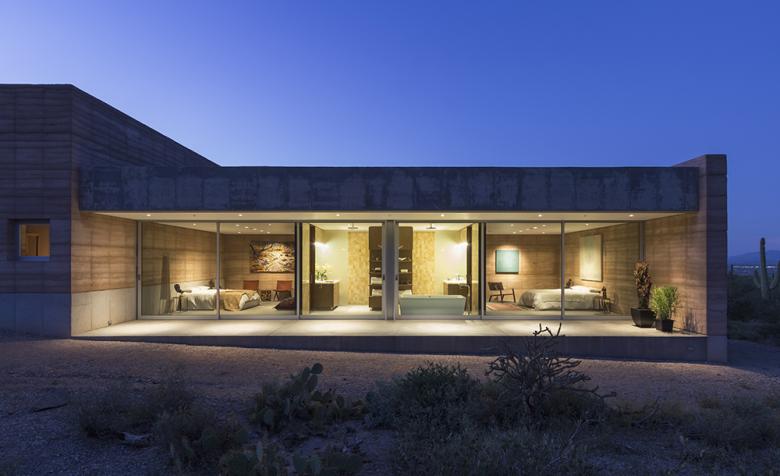Tucson Mountain Retreat
20. January 2014
If one thing will shape the course of the 21st century it is water, which will rise along coastlines but become scarce in other parts of the world. One area that is used to the scarcity of water is the American Southwest, particularly Arizona. With such little rainfall and a straining on other sources of fresh water, architects and clients need to design accordingly. DUST's mountain retreat outside Tucson can harvest 30,000 gallons of rainwater, filtering "our most precious resource available for all household uses." The architects answered a few questions about the rammed earth dwelling in the Sonoran Desert.
North elevation
What were the circumstances of receiving the commission for this project?
This project is a residence for a family of three. After two years of conversation the clients gave DUST full artistic control but were also integral to every decision made on the project. We had a close relationship with the client.
Looking toward the southeast
Please provide an overview of the project.
The Tucson Mountain Retreat is located within the Sonoran Desert; an extremely lush, exposed, arid expanse of land that emits a sense of stillness and permanency, and holds mysteries of magical proportions. Intentionally isolating the parking over 400 feet from the house, one must traverse and engage the desert by walking along a narrow footpath toward the house, passing through a dense clustered area of cacti and Palo Verde that obscure direct views of the home. Upon each progressive footstep, the house slowly reveals itself, rising out of the ground. The entry sequence, a series of playfully engaging concrete steps, dissolves into the desert. As one ascends, each step offers an alternative decision and a new adventure. Through this process, movement slows and senses are stimulated, leaving the rush of city life behind.
The approach from the east to the entry
The home is primarily made of rammed earth, a material that uses widely available soil, provides desirable thermal mass and has virtually no adverse environmental side effects. Historically vernacular to arid regions, it fits well within the Sonoran Desert, while at the same time it embodies inherent poetic qualities that engage the visual, tactile and auditory senses of all who experience it.
The program of the home is divided into three distinct and isolated zones: living, sleeping, and music recording/home entertainment. Each zone must be accessed by leaving the occupied zone, stepping outside, and entering a different space. This separation resolves the client's desired acoustic separation while at the same time offers a unique opportunity to continuously experience the raw desert landscape.
The sheltered view to the south from the patio off the living area
What are the main ideas and inspirations influencing the design of the building?
The Sonoran Desert. The home is carefully sited in response to the adjacent arroyos, rock out-croppings, ancient cacti, animal migration paths, air movement, sun exposure and views. Great effort was invested to minimize the physical impact of the home in such a fragile environment, while at the same time attempting to create a place that would serve as a backdrop to life and strengthen the sacred connections to the awe-inspiring mystical landscape.
The music studio and its direct access to the patio
How does the building relate to contemporary architectural trends, be it sustainability, technology, etc.?
Rooted in the desert, where water is always scarce, the design incorporates a generous 30,000 gallon rainwater harvesting system with an advanced filtration system that makes our most precious resource available for all household uses.
Solar heat gain is reduced by orienting the house in a linear fashion along an east–west axis, and by minimizing door and window openings in the narrow east and west facades. The main living and the sleeping spaces extend into patios and open toward the south under deep overhangs that allow unadulterated views and access to the Sonoran Desert. The overhangs provide shelter from the summer sun while allowing winter sunlight to enter and passively heat the floors and walls. They also scoop prevailing southerly breezes and enhance cross ventilation, which can be flexibly controlled by adjusting the floor-to-ceiling sliding glass doors. When the large glass doors are fully opened, the house is transformed, evoking a boundless ramada-like spirit where the desert and home become one.
The view to the north from the living area
How would you describe the architecture of Arizona and how does the building relate to it?
Arizona is a state rich in history and culture, much as most of the west. A great deal of the history is lost or forgotten and covered over by the “general youth” of western cities, with modern technology. The Tucson Mountain Retreat uses earthen building materials as the main material for building; locally sourced, it is from Arizona. The great mystique, awe and love for the desert is also incorporated into the design by opening each space onto the desert, thus allowing the desert to be the boundaries of the home when the spaces are opened.
Email interview conducted by John Hill.
Star-gazing deck
One of the two bedrooms
The two bedrooms and bathrooms at dusk
Floor plan and longitudinal section
Tucson Mountain Retreat
2012
Tucson Mountains, Arizona
Client
Withheld
Architect
DUST
Design Principal/Project Architect
Cade Hayes
Project Manager
Jesus Robles
Project Team
Dale Rush
Structural Engineer
Harris Engineering Services
Plumbing/Mechanical Engineer
Otterbein Engineering
Electrical Engineer
Matthews Consulting & Design
Lighting Designer
Claudia Kappl
Interior Designer
DUST
General Contractor
DUST
Site Area
6.3 acres
Building Area
3,634 square feet (plus 2,152 s.f. outdoor living space and 700 s.f. carport utility room)
Photographs
Jeff Goldberg/Esto
Drawings
DUST
Related articles
-
Spotlight on Italy
on 5/16/18
-
Bologna Shoah Memorial
on 7/20/15


